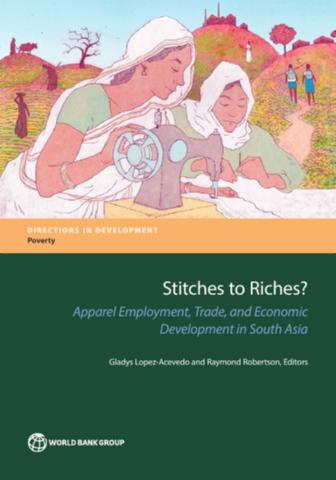Stitches to riches?: apparel employment, trade, and economic development in South Asia
 South Asia is in the midst of a demographic transition. For the next three decades, the growth of the region’s working age population will far outpace the growth of dependents. Close to one million individuals will enter the workforce every month. This large, economically active population can increase the region’s capacity to save and make crucial investments in physical capital, job training, and technological advancement. But for South Asia to realize these dividends, it must ensure that its working-age population is productively employed. As one of the most prominent labor-intensive industries in developing countries, apparel manufacturing is a prime contender. With around 4.7 million workers in the formal sector and another estimated 20.3 million informally employed (combined with textiles), apparel already constitutes close to 40 percent of manufacturing employment. And given that much of apparel production continues to be labor-intensive, the potential to create more and better jobs is immense. There is a huge window of opportunity now for South Asia, given that China, the dominant producer for the last ten years, has started to cede some ground due to higher wages. But the region faces strong competition from East Asia—with Cambodia, Indonesia, and Vietnam already pulling ahead. Plus the sector suffers from production inefficiencies and policy bottlenecks that have prevented it from achieving its potential. Against this backdrop, this report hopes to inform the debate by measuring the employment gains that the four most populous countries in South Asia—Bangladesh, India, Pakistan and Sri Lanka (hereafter `SAR countries’)—can expect in this new environment of increased competition and scrutiny. Its main message is that it is important for South Asian economies to remove existing impediments and facilitate growth in apparel to capture more production and create more employment as wages rise in China. The successful manufacturers will be those who can supply a wide range of quality products to buyers rapidly and reliably—not just offer low costs.
South Asia is in the midst of a demographic transition. For the next three decades, the growth of the region’s working age population will far outpace the growth of dependents. Close to one million individuals will enter the workforce every month. This large, economically active population can increase the region’s capacity to save and make crucial investments in physical capital, job training, and technological advancement. But for South Asia to realize these dividends, it must ensure that its working-age population is productively employed. As one of the most prominent labor-intensive industries in developing countries, apparel manufacturing is a prime contender. With around 4.7 million workers in the formal sector and another estimated 20.3 million informally employed (combined with textiles), apparel already constitutes close to 40 percent of manufacturing employment. And given that much of apparel production continues to be labor-intensive, the potential to create more and better jobs is immense. There is a huge window of opportunity now for South Asia, given that China, the dominant producer for the last ten years, has started to cede some ground due to higher wages. But the region faces strong competition from East Asia—with Cambodia, Indonesia, and Vietnam already pulling ahead. Plus the sector suffers from production inefficiencies and policy bottlenecks that have prevented it from achieving its potential. Against this backdrop, this report hopes to inform the debate by measuring the employment gains that the four most populous countries in South Asia—Bangladesh, India, Pakistan and Sri Lanka (hereafter `SAR countries’)—can expect in this new environment of increased competition and scrutiny. Its main message is that it is important for South Asian economies to remove existing impediments and facilitate growth in apparel to capture more production and create more employment as wages rise in China. The successful manufacturers will be those who can supply a wide range of quality products to buyers rapidly and reliably—not just offer low costs.
